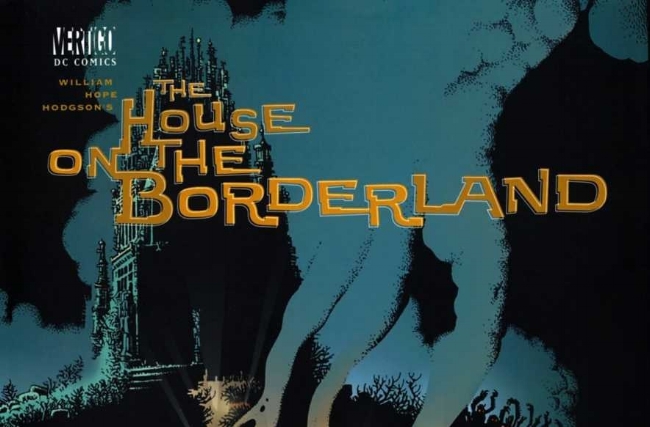The House on the Borderland by William Hope Hodgson (2000)
The House on the Borderland is a Vertigo comics graphic novel version of the 1908 baroque supernatural story by Edwardian writer, William Hope Hodgson. Adapted by Richard Corben and Simon Revelstroke, with illustrations are by Richard Corben of Hellblazer and Heavy Metal fame, The House on the Borderland proves to be a bold and innovative visual retelling of a rather densely narrated tale. The story tells a tale of two gentlemen on a week’s fishing holiday in the Irish village of Kraighten in the mid-fifties. Whilst exploring the local countryside they discover the ruins of a very curious house that appears to have been swallowed by a sinkhole. They subsequently find what appears to be the diary of its former owner. The torn pages seem to hint at an evil presence that was slowly and irresistibly encroaching upon the property. The author alludes to other events such as strange beasts in the ground at night and his own worsening nightmares. Is any of it to be believed, or is it simply the ravings of a deluded mind?
William Hope Hodgson’s original novel is an extremely difficult story to adapt to the graphic novel format. Most of the source text is written as diary entries, in which it describes arcane forces, astral projection and esoteric visions. Blending supernatural paranoia, fantasy and Lovecraftian horror in a first-person narrative that hints rather than discloses, it’s a tough book to crack. Yet Corben and Revelstroke make an inspired effort in condensing the text and visually extrapolating the complex descriptions. The artwork is innovative and does a good job of capturing the dark and eldritch tone of the story. The text adaptation strives to be as faithful to the source material as it can, yet inevitably has to relinquish on some of the more esoteric themes which are too difficult to render visually. However, the essential ideas of the original story are not only present but prove to be quite accessible. The understated approach of the artwork in keys scenes captures the menace conveyed by William Hope Hodgson in his original story.
Featuring an introduction by comics luminary Alan Moore that offers an affectionate appreciation of Hodgson's contribution to the horror genre, The House on the Borderland is a valiant attempt to bring a classic cerebral work to a wider audience via a very visual medium. Ultimately, the adaptation cannot offer the exact same experience as reading the original novel, but it must be applauded for bringing such material to a wider audience. It certainly succeeds in tapping into that disquieting quality that porcine horror can have, hinting at beasts who may well have a comparable intelligence to humans, while harbouring an inherent enmity to us as a species. Hopefully after reading The House on the Borderland, graphic novel horror fans will subsequently seek out and familiarise themselves with William Hope Hodgson’s other work, which is the equal to that of H.P. Lovecraft. I would certainly like to see further visual adaptations of the authors back catalogue.





